For many teams, pre-season will be well underway, with top-level teams enjoying tours across the world.
Teams such as Scottish Premiership side Celtic, and Premier League teams Manchester United and Liverpool have already played a series of pre-season friendlies in the United States.
This tactical analysis focuses on passing activation exercises that coaches can use during their own pre-season training sessions.
Similar examples to those deployed in training sessions by the teams mentioned are described in this analysis.
This tactical theory will offer three examples of passing activation sequences that can be incorporated as part of the warm-up prior to the main body of the training session.
The exercises are designed to work on players’ passing abilities and off-the-ball movement with the key aim of preparing the players both physiologically and psychologically for the session that follows.
The exercises are all highly functional and are crafted to prepare players for specific technical components that may arise later in the practice, as well as improve players on those technical facets.
Combining With The “10”
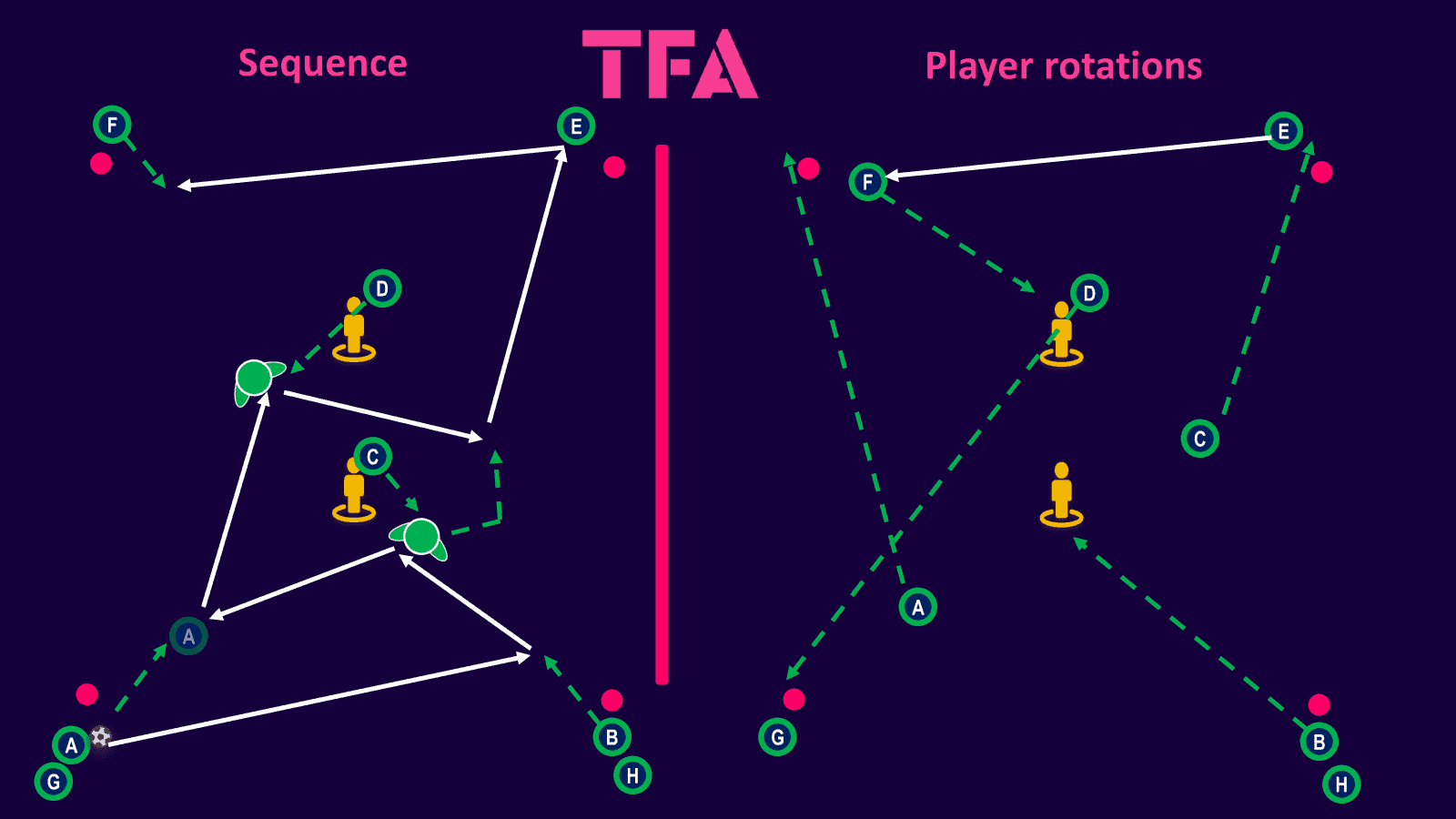
This passing activation drill could be used in preparation for a session designed to work on playing with a “10” and one striker, or “9”.
Alternatively, it could be used by teams when developing their build-up play using a single pivot or “6”.
The sequence begins with the ball being switched from one “midfielder” to the other. ‘C’, or the ‘10’, makes a movement from behind the first mannequin to receive from ‘B’ and play a bounce pass into “A’.
As the ball is laid back, the ’10’ should open their body up and drift away on the mannequin’s blind side.
The ‘9’, or ‘D’, makes a similar movement to receive from ‘A’.
The ’10’ then receives a weighted bounce pass from his striker.
The pace of the backwards pass allows the ‘10’ to play with his first touch into the opposite end player.
This pass from the ’10’ represents playing a defence-splitting through the ball for a winger to run onto.
The sequence is then repeated in the opposite direction.
The players rotate as shown on the right of the diagram.
‘A’ moves directly opposite, replacing ‘F’ with player ‘B’ replacing ‘C’ (the ‘10’).
‘C’ follows their pass into ‘E’.
‘D’ completes two sequences, one as the ‘9’ and one as the ‘10’ before ending up in player ‘A’s’ original starting point.
After playing into ‘D’, ‘F’ replaces ‘D’ with ‘G’, restarting the entire sequence.
This sequence, as described, has the players switching positions.
If the coach wants to concentrate on one or two players acting as the “10”, it can easily be adapted for the two central players to remain in those positions.
The “end players” simply join the opposite line after completing their combinations.
Coaches should emphasize the weight of the passes required. Some should be fast, line-breaking passes, whilst others should be weighted, slow passes to allow the next pass to be firm and crisp.
The player’s body orientation should be coached to enable the player to see where the ball is being received from and their next pass.
The body shape should also allow for maximum efficiency, i.e. as few touches as possible, when progressing the ball.
With the ’10’ being the key focus, the timing of their movements worked on.
The aim is to burst into space at the last moment, using the previous player’s first touch as a trigger, to make the ’10’ difficult to mark.
Build-Up Diamond Sequence
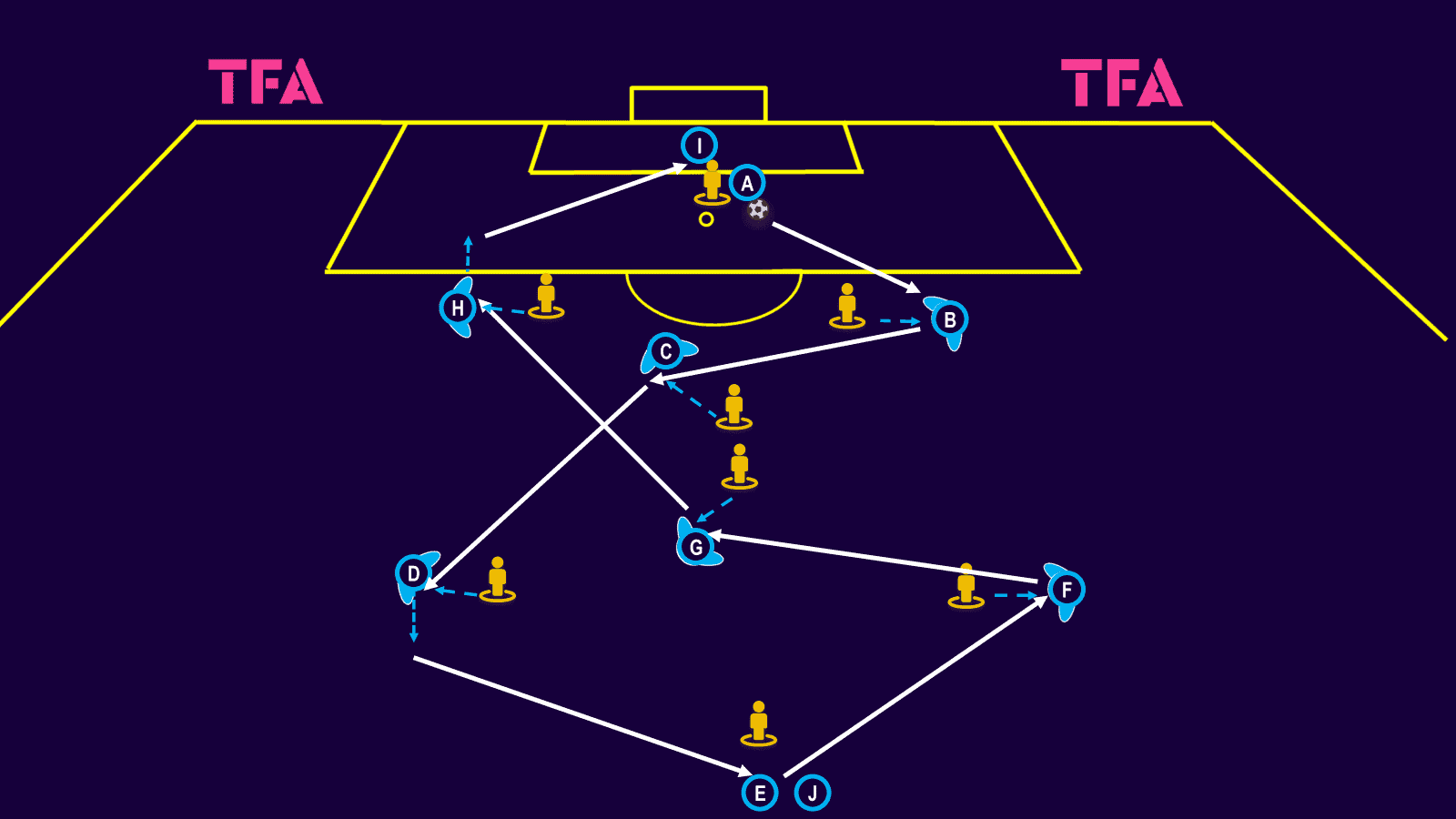
This, more generic passing sequence that works on several technical aspects, can be used specifically in preparation for working on build-up play but is easily adapted to work on other in-game scenarios.
The image above shows the distances for working on the build-up phase, but the sequence can be just as effective in a much more condensed area.
In this set-up, player ‘A’, representing the goalkeeper, passes into the left centre-back, who has opened up their body to allow the next action to be a pass into the ‘6’.
The ‘6’, using the centre-backs first touch as a trigger, drops to receive.
The ball is then quickly switched to the ball-far ‘8’.
The body shape of the ‘6’, facing forward when receiving, allows this pass to be played quickly with their second touch.
The ‘8’ should receive side on with their back foot to allow them to attack the space ahead by dribbling before playing into the ‘striker’, ‘E’.
Each player follows their pass and multiple balls can be used at one time.
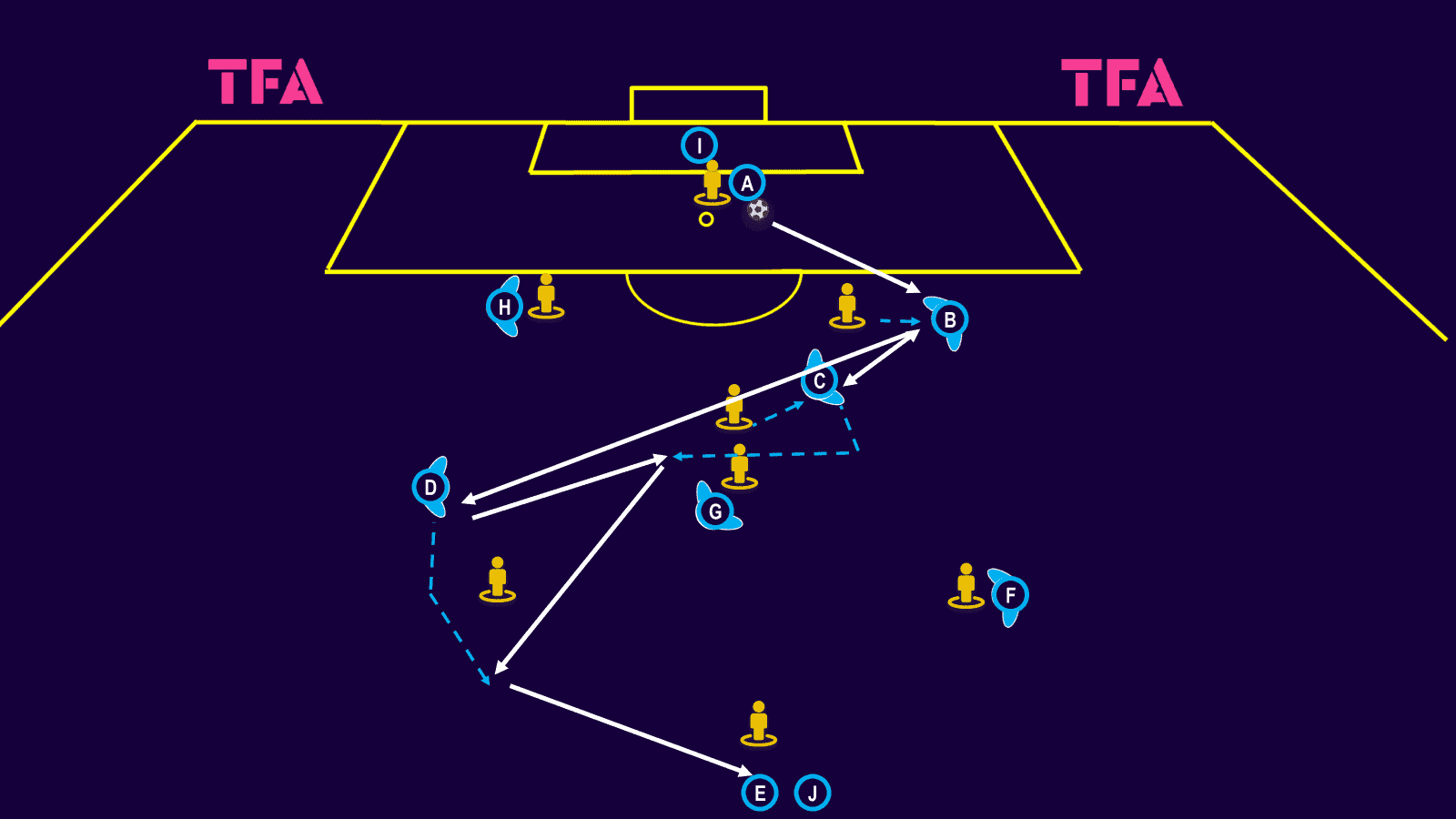
There are infinite progressions or adaptions to this sequence depending on the coach’s main goals.
The option shown in the above diagram has the ‘6’ coming towards the centre-back and playing a bounce pass before clearing the area.
This opens up a pass directly from the centre-back into the ball-far ‘8’, who has dropped to a lower position.
The ‘8’ then lays back to the ‘6’ before receiving behind the mannequin.
Levels of complexity, dependent on the level of the player working with, can be added to overload the players perceptually and cognitively.
The theory is that overloading the players with information at this stage will make the tactical component of the session, or a real match, feel relatively easy.
Thomas Tuchel, a disciple of differential learning, is known for a similar session design philosophy.
An example of this complexity could be to add shadow, or even full, defending players.
More complex, hard-to-remember passing combinations can also be incorporated to distract the players from concentrating on their passing actions.
Pressing Activation
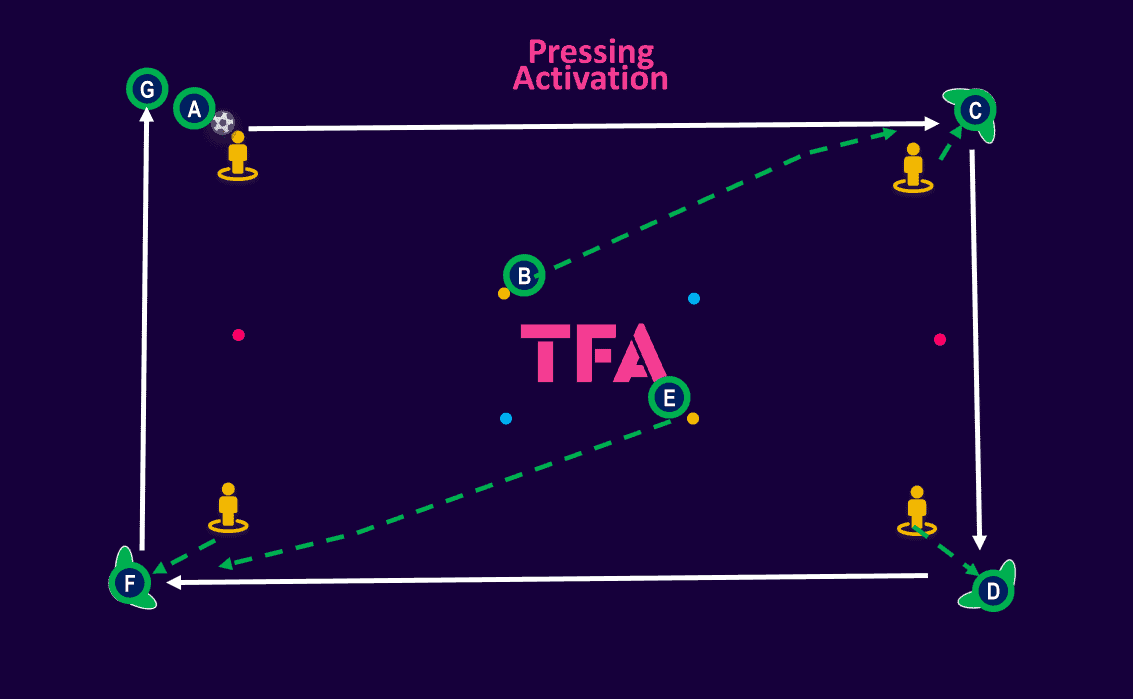
This exercise is designed to prepare players, specifically the forwards, for a high-intensity pressing session.
The runs are designed to work on the tactical movements when pressing and to prepare the players, on a slightly smaller scale, for the physiological demand of the practice to come.
The sequence of the ball movement is simple, with it constantly moving on the outside of the square.
The exercise begins with player ‘A’ playing a firm pass into player ‘C’.
Player ‘B’, representing a centre-forward, sprints with a slight curve at ‘C’s’ inside foot as soon as the pass is released.
The run from the striker is designed to force ‘C’, representing a left centre-back or full-back, to keep going down that side of the pitch.
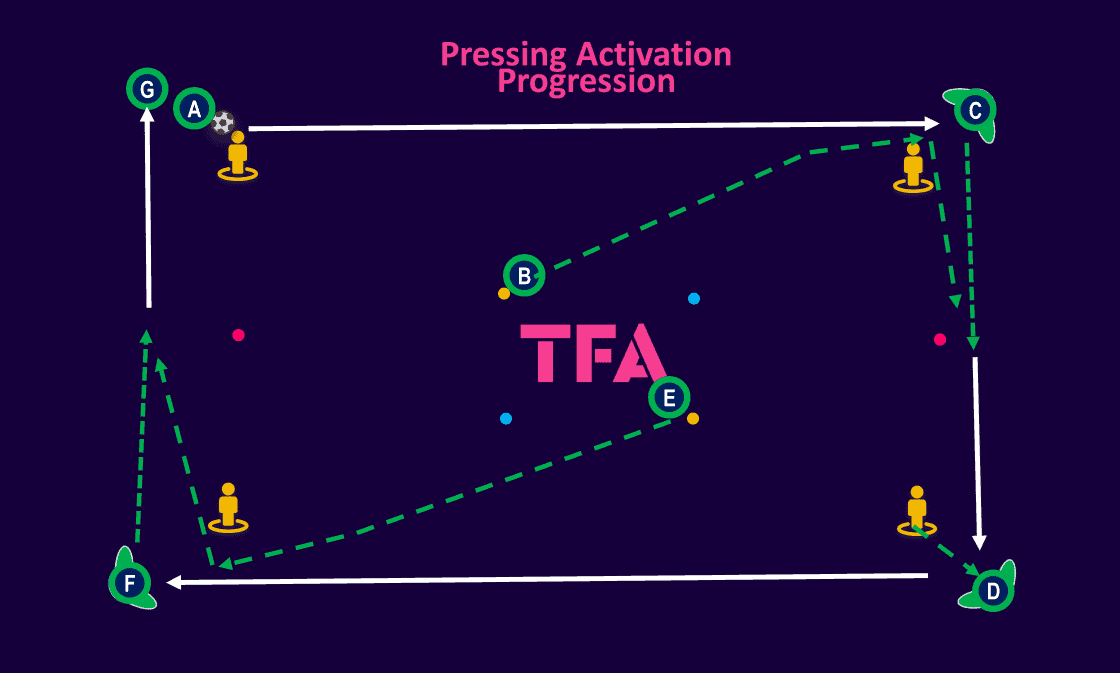
The exercise can progress to where the receiving centre-back has to accelerate with the ball and dribble past halfway (pink cone) before releasing the ball.
This works on the pressing players’ change of direction and adds a greater element of competition to the drill.
A decision-making element can also be added with the in-possession players deciding whether or not to run with the ball or play with their second touch.
Once the decision has been made to dribble, they must commit and not release the ball until they reach the pink cone.
Conclusion
Incorporating these passing activation exercises into pre-season training sessions provides a structured approach to enhancing technical skills and tactical awareness.
The activation drills should be selected with the rest of the session, and the main tactics and technical points of emphasis, in mind.
The physiological output expected of the players during the main session, for example, high-intensity or long-distance sprints should also be considered and prepped for during this phase.
Passing activation exercises can allow coaches to get more out of their sessions by embedding certain skills and movements in a more condensed environment that allows for lots of repetition and coaching points.
After this phase, the players should be technically, tactically and physically prepared for what is to come.






Comments